INSTITUT SUPERIEUR D'ANTHROPOLOGIE
INSTITUTE OF ANTHROPOLOGY
ONLINE COURSES / COURS A DISTANCE
WINTER TERM : JANUARY 2014
REGISTER NOW
BULGARIE – 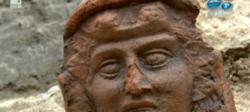 Plovdiv -Archaeologists working on the digs at the Roman-era forum in Bulgaria’s second-largest city of Plovdiv have uncovered a full-size statue, presumed to date back to the fourth century CE, public broadcaster Bulgarian National Television (BNT) reported. The life-sized statue is believed to depict a high magistrate holding a scroll. This is the first find of this kind in Plovdiv, with archaeologists previously uncovering only fragments of statues, used for later construction during the medieval times. The statue was likely erected during the last years when the Roman forum was still the focus of civic life, before the ascent of Christianity shifted the focus to churches. Given the cooling weather conditions, archaeologists will secure the statue for the winter and will resume digs in the spring of 2014, archaeologist Boris Draganov is quoted as saying. Once fully unearthed and cleaned, the statue is expected to go on display either at Plovdiv’s archaeological museum or at the forum site where it was discovered.
Plovdiv -Archaeologists working on the digs at the Roman-era forum in Bulgaria’s second-largest city of Plovdiv have uncovered a full-size statue, presumed to date back to the fourth century CE, public broadcaster Bulgarian National Television (BNT) reported. The life-sized statue is believed to depict a high magistrate holding a scroll. This is the first find of this kind in Plovdiv, with archaeologists previously uncovering only fragments of statues, used for later construction during the medieval times. The statue was likely erected during the last years when the Roman forum was still the focus of civic life, before the ascent of Christianity shifted the focus to churches. Given the cooling weather conditions, archaeologists will secure the statue for the winter and will resume digs in the spring of 2014, archaeologist Boris Draganov is quoted as saying. Once fully unearthed and cleaned, the statue is expected to go on display either at Plovdiv’s archaeological museum or at the forum site where it was discovered.
http://sofiaglobe.com/2013/11/26/fourth-century-ce-magistrate-statue-uncovered-in-bulgarias-plovdiv/
PEROU – 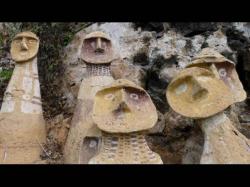 Amazone -Archaeologists working in the Amazonas region of Peru have discovered 35 sarcophagi belonging to the Chachapoyas culture.Diminutive size of sarcophagi has led archaeologists to believe that it may be a cemetery exclusively for children. Peru21 reports that the find was made this past July with the help of a super long zoom camera. In September, researchers were able to reach the site to confirm the find and discovered that the sarcophagi were only about 70 centimeters tall on average. Researchers believe that the group of sarcophagi may constitute a cemetery in which only children were buried. According to Peru21, the burial site is unique in that the sarcophagi were buried facing west, which is unusual for Chachapoyas cemeteries. Manuel Cabañas López of the regional Ministry of Exterior Commerce and Tourism told press “Because of the magnitude of the find, we’re dealing with a discovery that is unique in the world, which should be protected and integrated into the touristic circuit.” The Chachapoyas culture (sometimes referred to as “The Warriors of the Clouds”) were a powerful civilization that flourished from about 800 AD until shortly before the Spanish conquest of the New World, when they were conquered by the Inca empire. They are known for constructing the jungle fortress of Kuelap, an impressive complex located in Chachapoyas, Amazonas, in northern Peru.
Amazone -Archaeologists working in the Amazonas region of Peru have discovered 35 sarcophagi belonging to the Chachapoyas culture.Diminutive size of sarcophagi has led archaeologists to believe that it may be a cemetery exclusively for children. Peru21 reports that the find was made this past July with the help of a super long zoom camera. In September, researchers were able to reach the site to confirm the find and discovered that the sarcophagi were only about 70 centimeters tall on average. Researchers believe that the group of sarcophagi may constitute a cemetery in which only children were buried. According to Peru21, the burial site is unique in that the sarcophagi were buried facing west, which is unusual for Chachapoyas cemeteries. Manuel Cabañas López of the regional Ministry of Exterior Commerce and Tourism told press “Because of the magnitude of the find, we’re dealing with a discovery that is unique in the world, which should be protected and integrated into the touristic circuit.” The Chachapoyas culture (sometimes referred to as “The Warriors of the Clouds”) were a powerful civilization that flourished from about 800 AD until shortly before the Spanish conquest of the New World, when they were conquered by the Inca empire. They are known for constructing the jungle fortress of Kuelap, an impressive complex located in Chachapoyas, Amazonas, in northern Peru.
http://www.peruthisweek.com/news-archaeologists-discover-chachapoyas-sarcophagi-in-amazonas-peru-101585
CHINE -Shimao - Archaeologists said fortifications of the largest neolithic Chinese city ever discovered were excavated on Wednesday and Thursday in northwest China's Shaanxi Province. The ruins of two square beacon towers, once part of the city wall of the 4,000-year-old Shimao Ruins in Shenmu County, have been uncovered, according to Shaanxi Provincial Institute of Archaeology. One of the towers is 18 meters long, 16 meters wide and four meters tall, while the other is 11.7 meters long, about 10 meters wide and three meters tall, said Su Zhouyong, deputy head of the institute. Sun said the discovery is a breakthrough and contributes greatly to archaeological research on ancient Chinese fortifications. The Shimao Ruins were first found in 1976 in the form of a small town, and archaeological authorities only identified the ruins as part of a much larger city -- the largest of its kind from neolithic time -- last year after measuring the exact size of the ancient stone city. The city was found to have a central area, and inner and outer structures. The walls surrounding the outer city extended over an area of 4.25 square kilometers. Archaeologists said it was built about 4,300 years ago and was abandoned roughly 300 years later during the Xia Dynasty, the first dynasty in China to be described in ancient historical chronicles.
http://news.xinhuanet.com/english/sci/2013-11/28/c_132926622.htm
ROYAUME UNI – 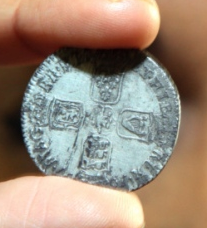 Dunfermline - Priceless artefacts which have changed thinking on medieval life in Scotland’s ancient capital were on show as the archaeology team of experts and volunteers behind Dig Dunfermline explained their treasure trove to the public. Last summer’s extensive dig was organised in advance of work getting under way on the site of Dunfermline’s new £10.8 million museum and art gallery. A North German stove tile, pipes and fragments of leather were found in what Fife Council archaeologist Douglas Speirs hailed as an “exemplar approach” in community archaeology.
Dunfermline - Priceless artefacts which have changed thinking on medieval life in Scotland’s ancient capital were on show as the archaeology team of experts and volunteers behind Dig Dunfermline explained their treasure trove to the public. Last summer’s extensive dig was organised in advance of work getting under way on the site of Dunfermline’s new £10.8 million museum and art gallery. A North German stove tile, pipes and fragments of leather were found in what Fife Council archaeologist Douglas Speirs hailed as an “exemplar approach” in community archaeology.
http://www.thecourier.co.uk/news/local/fife/priceless-artefacts-from-dunfermline-s-medieval-past-on-show-1.158951
TURQUIE – 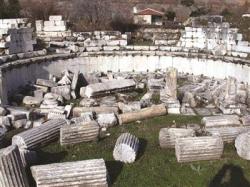
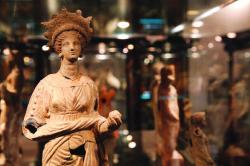 Stratonikeia - The head of the Stratonikeia Ancient City excavations, Professor Bilal Söğüt, said Stratonikeia was home to many civilizations in the past, and therefore the site contained many artifacts and traces from the Ottoman, Roma, Byzantium eras. Söğüt attended the conference “Stratonikeia, from Ancient times to Present” at Muğla Sıtkı Koçman University Mediterranean Research and Application Center (AKMEDAM). In his speech Söğüt said they had started the excavation works in Karia area’s inner parts in 2008. Noting that they had been continuing the research in the city, Söğüt said they had erected many important buildings and parts of the city. Söğüt said some of the artifacts had already been sent to museums and the broken stones were sent to the Stone Hospitals to be fixed. There is no other ancient city like Stratonikeia, said Söğüt, adding the city has Ottoman era stones on its roads and that’s why it is very important.This year the Imperial Temple is being unearthed using a 3D method, he said. He said works in the area of the Temple of Emperors unearthed structures like a Roman bath, a temple, a Seljuk mosque and a Turkish house. We knew that a 2,600-year-old place of worship existed here. Research has determined that the Augustus Temple was built here,” he said, adding the temple found during the excavations dated back 2,000 years ago. He added that some of the sculpture-like artifacts found in excavations were being housed in museums. “There were some sculptures in the temple. This is why ceremonies were held inside and around the temple. These ceremonies show that this area was [deemed] holy. But earthquakes occurred in this era and the temple, as well as many other structures, was ruined. Many of these structures could not have been revamped after the earthquakes, especially the one in 360. We found the temple’s columns,” Söğüt said.
Stratonikeia - The head of the Stratonikeia Ancient City excavations, Professor Bilal Söğüt, said Stratonikeia was home to many civilizations in the past, and therefore the site contained many artifacts and traces from the Ottoman, Roma, Byzantium eras. Söğüt attended the conference “Stratonikeia, from Ancient times to Present” at Muğla Sıtkı Koçman University Mediterranean Research and Application Center (AKMEDAM). In his speech Söğüt said they had started the excavation works in Karia area’s inner parts in 2008. Noting that they had been continuing the research in the city, Söğüt said they had erected many important buildings and parts of the city. Söğüt said some of the artifacts had already been sent to museums and the broken stones were sent to the Stone Hospitals to be fixed. There is no other ancient city like Stratonikeia, said Söğüt, adding the city has Ottoman era stones on its roads and that’s why it is very important.This year the Imperial Temple is being unearthed using a 3D method, he said. He said works in the area of the Temple of Emperors unearthed structures like a Roman bath, a temple, a Seljuk mosque and a Turkish house. We knew that a 2,600-year-old place of worship existed here. Research has determined that the Augustus Temple was built here,” he said, adding the temple found during the excavations dated back 2,000 years ago. He added that some of the sculpture-like artifacts found in excavations were being housed in museums. “There were some sculptures in the temple. This is why ceremonies were held inside and around the temple. These ceremonies show that this area was [deemed] holy. But earthquakes occurred in this era and the temple, as well as many other structures, was ruined. Many of these structures could not have been revamped after the earthquakes, especially the one in 360. We found the temple’s columns,” Söğüt said.
http://www.hurriyetdailynews.com/conference-reveals-many-secrets-in-ancient-city-of-stratonikeia.aspx?pageID=238&nID=58621&NewsCatID=375
VIET NAM - 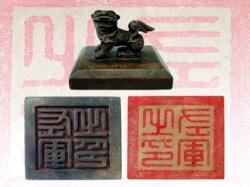 Ho Chi Minh City authorities have asked the Ministry of Culture, Sports and Tourism to recognize 46 items as national treasures, including an ancient seal, several banknote zincographs, Roman coins, king clothing... These objects are being preserved by several agencies in the city. Of these, 12 objects are kept by the HCM City Museum, including the seal of Military Governor Le Van Duyet, which was cast in 1802 and 11 banknote zincographs of Vietnam from 1946 to 1952. The bronze seal of Military Governor Le Van Duyet weighs 1.82 kg, 7.2 cm high, carved with four Chinese scripts meaning the seal of the Military Governor. Photo: HCM City Museum.The HCM City Fine Arts Museum has 23 exhibits, including a lacquer painting and 22 sketches related to this work by Nguyen Gia Tri, Vietnam's leading lacquer painter. The remaining items, consisting of a Roman coin, seven statues, a bronze seal, a King coat and a prince coat being held in Ho Chi Minh City History Museum are preserved at the HCM City Museum of History. In January 2012, Prime Minister Nguyen Tan Dung signed a decision recognizing the first over 30 national treasures of Vietnam, including a Ngoc Lu bronze drum, a Hoang Ha bronze drum, a Dao Thinh jar, a seal of the Tran Dynasty, a pottery vase of the Later Le Dynasty, a copper statue featuring one carrying another on his back of the Dong Son Culture, a Canh Thinh bronze drum of the Tay Son Dynasty, the works by President Ho Chi Minh, etc..
Ho Chi Minh City authorities have asked the Ministry of Culture, Sports and Tourism to recognize 46 items as national treasures, including an ancient seal, several banknote zincographs, Roman coins, king clothing... These objects are being preserved by several agencies in the city. Of these, 12 objects are kept by the HCM City Museum, including the seal of Military Governor Le Van Duyet, which was cast in 1802 and 11 banknote zincographs of Vietnam from 1946 to 1952. The bronze seal of Military Governor Le Van Duyet weighs 1.82 kg, 7.2 cm high, carved with four Chinese scripts meaning the seal of the Military Governor. Photo: HCM City Museum.The HCM City Fine Arts Museum has 23 exhibits, including a lacquer painting and 22 sketches related to this work by Nguyen Gia Tri, Vietnam's leading lacquer painter. The remaining items, consisting of a Roman coin, seven statues, a bronze seal, a King coat and a prince coat being held in Ho Chi Minh City History Museum are preserved at the HCM City Museum of History. In January 2012, Prime Minister Nguyen Tan Dung signed a decision recognizing the first over 30 national treasures of Vietnam, including a Ngoc Lu bronze drum, a Hoang Ha bronze drum, a Dao Thinh jar, a seal of the Tran Dynasty, a pottery vase of the Later Le Dynasty, a copper statue featuring one carrying another on his back of the Dong Son Culture, a Canh Thinh bronze drum of the Tay Son Dynasty, the works by President Ho Chi Minh, etc..
http://english.vietnamnet.vn/fms/art-entertainment/90052/hcm-city-seeks-recognition-of-46-national-treasures.html
EGYPTE – 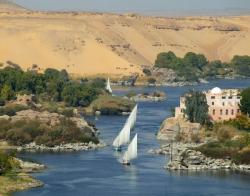 Assouan - Aswan Tourism and Antiquities Investigation department was able to find four mummies and other archaeological articrafts dating back to the Roman and Greek eras in a mountainous area west of the Nile in Aswan.The treasures were found after a group of thieves tried to steal them. The other articrafts also include two stone pieces with Pharaonic inscriptions, also dating back to the same period, in addition to some wooden vessels. The prosecution ordered that the findings be handed to Aswan antiquities department and to prepare a report about their archaeological value. Authorities are in search for the thieves who attempted to steal the articrafts.
Assouan - Aswan Tourism and Antiquities Investigation department was able to find four mummies and other archaeological articrafts dating back to the Roman and Greek eras in a mountainous area west of the Nile in Aswan.The treasures were found after a group of thieves tried to steal them. The other articrafts also include two stone pieces with Pharaonic inscriptions, also dating back to the same period, in addition to some wooden vessels. The prosecution ordered that the findings be handed to Aswan antiquities department and to prepare a report about their archaeological value. Authorities are in search for the thieves who attempted to steal the articrafts.
http://archaeologynewsnetwork.blogspot.fr/2013/11/four-mummies-found-in-aswan-after.html#.UpeZksTuLVQ